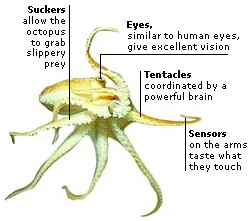DK Nature: Mollusks
Soft-bodied invertebrates, mollusks include slugs, snails, octopuses, squid, clams, and mussels. Most mollusks have SHELLS to protect them.
As well as a shell, most mollusks have a muscular foot for creeping or burrowing. Some also have a head with sense organs. The soft body includes lungs or gills for breathing, and digestive and reproductive parts, all enclosed by a skinlike organ called the mantle.
Most mollusks have a rasping tongue called a radula, armed with tiny teeth. This scrapes tiny plants and animals off rocks or tears food into chunks. Bivalves, such as oysters and mussels, filter food particles from the water with their gills.
Mollusks reproduce sexually. Slugs and snails are hermaphrodites (possessing both male and female organs), but they must still mate to fertilize their eggs. Most aquatic mollusks lay eggs that hatch into small, free-swimming larvae called veliger.
There are over 70,000 mollusk species split into several major classes:
| Gastropods (the largest class) include slugs, snails, winkles, whelks, and limpets |
| Bivalves include scallops, clams, and oysters |
| Squid, octopuses, cuttlefish, and nautilus are cephalopods |
| Smaller groups include tusk shells and chitons (oval mollusks with jointed plates) |
Mollusk shells come in many shapes and sizes, but most have the same, simple function—providing somewhere to hide in times of danger. In land mollusks, the shell also helps to prevent the moist, soft-bodied creature from drying out.
Mollusk shells are made of a chalky material called calcium carbonate. The shell has three layers for extra strength: a tough outer layer, a chalky middle layer, and a shiny inner layer, next to the animal’s skin. The shiny layer in some bivalve mollusks is known as mother-of-pearl.
A mollusk’s mantle (skin) releases liquid shell materials, which harden on contact with water or air. Gastropod and nautilus shells grow from their outermost edge. As the mollusk grows, its shell develops more whorls (single turns in a spiral shell) or chambers. In bivalves, new shell material is deposited on the edge that is farthest from the hinge.

